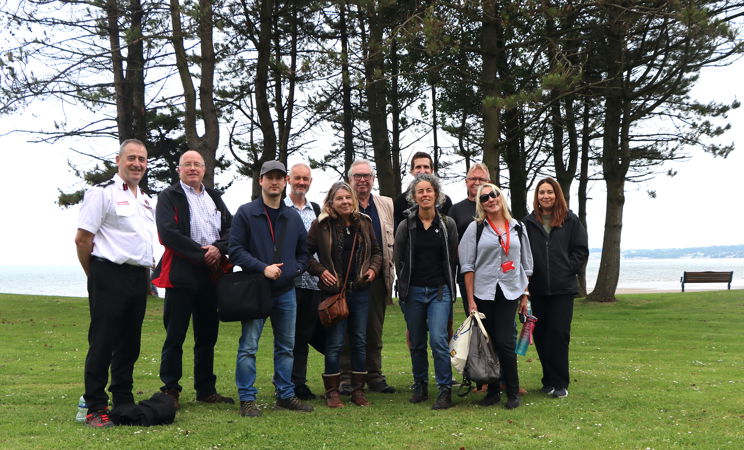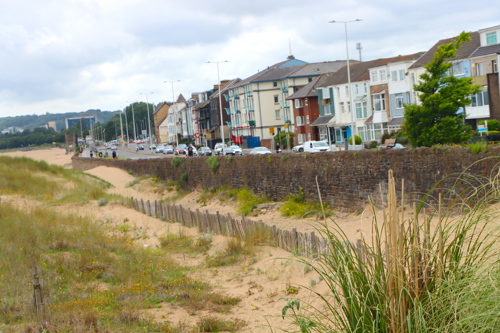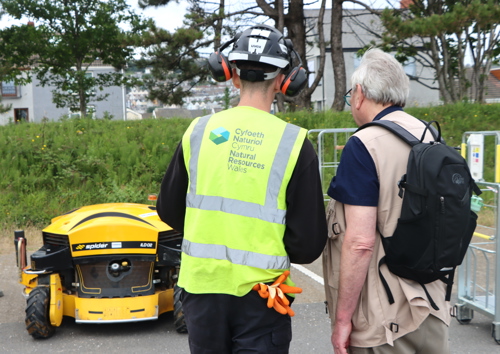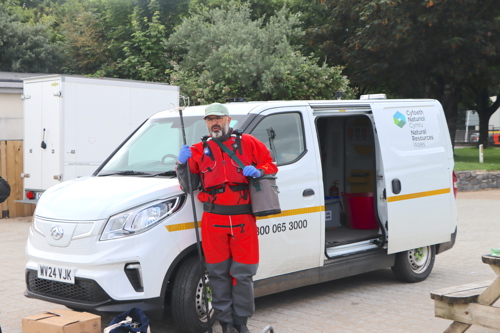Walking in our shoes in Swansea, south west Wales

Did you know that in south west Wales alone, Natural Resources Wales (NRW) manages over 2,040 flood defence assets? Or that we monitor the water quality at eight designated bathing beaches in Swansea throughout the summer?
These are just a couple of examples of the work happening behind the scenes, often unnoticed but absolutely vital to keeping people and nature safe, healthy, and thriving.
As someone working in the People and Places team at Natural Resources Wales, I had the pleasure of recently welcoming members of the Swansea Public Service Board (PSB) on a walking tour entitled Walking in Our Shoes. The event gave our PSB partners a closer look at what we do; not just in reports or strategies, but on the ground, where it really matters.
Our team connects people, policy and place, making sure our work reflects local priorities, builds community resilience, and responds to the challenges of climate change and biodiversity loss. We also lead the delivery of the South West Area Statement, which shapes how we act on issues like health inequalities, sustainable land use, and ecosystem recovery.
This tour was about showing the real-world impact of what we do, and how working together makes that impact even stronger.
What is a Public Service Board and how does NRW fit in?
Public Services Boards (PSBs) were created under the Well-being of Future Generations (Wales) Act 2015. They bring together organisations like the local authority, health board, fire and rescue service, police, Natural Resources Wales, and others to improve the well-being of people in the area - socially, economically, environmentally, and culturally.
At NRW, we bring the environment into that conversation. Whether it's reducing flood risk, improving air and water quality, or increasing access to nature, our work directly supports the goals of the PSB.
This event was a chance for our partners to see that in action.
Marine team: reconnecting with the sea

Our first stop was with the Marine Team, led by James Moon, Marine Team Leader, who took us to Swansea Bay to explore the innovative sand dune creation project carried out by NRW and Swansea Council. This nature-based solution helps tackle the problem of wind-blown sand along the seafront, improving safety for pedestrians, cyclists and motorists and saving the council thousands in maintenance each year.
James spoke powerfully about the need for ocean literacy, reminding us that many people have lost their connection to the sea. Through projects like these and the launch of the Wales Ocean Literacy Strategy, NRW is helping people understand how important, and vulnerable, our marine environments are.
It was a great way to kick off the tour, seeing how practical solutions also bring environmental and social benefits.
Integrated workforce team: responding when it matters most
Next, Neil Davies, Integrated Workforce Team Leader, gave us an insight into the vital work of the Integrated Workforce Team, the dedicated individuals who work tirelessly, often behind the scenes and in tough conditions, to protect our communities and natural environments.
This highly skilled team provides 24/7 incident response cover, offering rapid on-the-ground support and expert advice when emergencies strike. Whether it’s flooding, wildfires, or pollution incidents, they respond providing back up and advice on site to further prevent environmental harm.
In addition to emergency response, the team manages 2,040 flood defence, 45km of raised defences and other environmental assets across the four counties of Pembrokeshire, Carmarthenshire, Swansea and Neath Port Talbot that form south west Wales. The team also maintains critical infrastructure within the Welsh Government Woodland Estate and help care for NRW’s network of nature reserves.
We saw a live demonstration of their robotic mowers that manage vegetation on NRW assets while reducing ground damage. This approach not only improves safety and efficiency but also helps preserve biodiversity on our flood assets, reservoirs and other NRW-managed land.
Neil emphasised that their work extends well beyond crises. From carrying out river maintenance to improving public access on nature trails, the team’s broad skillset and commitment are vital to NRW’s mission.

Green infrastructure: making cities greener and healthier
Led by our Green Infrastructure specialist, Fran Rolfe, our third stop focused on green infrastructure, with a visit to an urban rain garden and St Helen’s Primary School, a standout example of how we’re helping communities adapt to climate change in practical ways.
Urban rain gardens soak up rainwater, reducing pollution, flooding, and pressure on city drains. They also create green spaces that support wildlife and make cities cleaner and more attractive.
The school suffers serious surface water flooding. Rain gardens and sustainable drainage are being built at the school right now to make the grounds safer, greener and with the added bonus of reducing the risk of flooding. The project has also involved teachers, parents, and local contractors, showing how GI can build stronger communities, as well as better environments.
Flood risk management: building resilience together
We moved on to the site of where flood levels are said to have reached during the great flood of 1846 right next to Swansea Crown Court. On 29 January, 1846, Swansea was hit by a huge tidal surge that sent boats floating up Wind Street and flooded homes and shops. It was one of the town’s worst floods and a stark reminder of how powerful nature can be.
Our flood risk management expert, Lester Fulcher, outlined some of the ways we’re helping communities prepare for, and adapt to, more extreme weather and sea-level rise due to climate change.
One scheme that really stood out was in Crofty, north Gower. After building tidal and fluvial defences, the project was handed over to local residents, who now receive notifications from us and close the tidal gates themselves when required. This model has saved NRW over £30,000 a year in operational costs and empowered the community to take ownership of their resilience.
We also learned about a scheme in Pontarddulais, which has successfully prevented river flooding since it was installed, and the Tawe Vale flood project which protects Swansea’s Enterprise Zone and nearby homes.
As Lester put it, “You can build a wall, but how high do you want it?” These schemes aren’t just about engineering - they’re about making smart, evidence-based choices to protect the most properties possible with the limited resources available to us.
Bathing waters and water quality: science that keeps us safe
Our final stop was all about water quality. Hamish Osborn, Swansea’s Environment Team Leader, explained how we sample Swansea’s eight designated bathing waters throughout the summer.

Our laboratory staff based at Swansea University test samples for bacteria like E. coli and intestinal enterococci to make sure they’re safe for swimmers. Natalie Dudley Burton and Bethan Yule from our laboratory attended the event at Swansea Bay to demonstrate technology used by the sampling teams to take chemical readings in the field during the bathing waters season.
At Swansea Bay, a real-time prediction model has been developed that updates hourly and informs beachgoers via signs and online updates. It’s a great example of using technology to protect public health.
We were also given a fascinating look at invertebrate sampling by Julie Gething, an environmental assessment officer. She demonstrated how checking for insects and crustaceans like mayflies and shrimps, paints a picture of the long-term quality of that water. It was a reminder that the smallest creatures can tell the biggest stories.
A final reflection: from strategy to street level
As an organiser of this event, I was proud to see how many of our partners walked away not only more informed, but more inspired. They saw that our work isn’t just policy documents or plans on a shelf - it’s real, it’s local, and it’s collaborative.
Everything we showed ties directly back to the priorities in our South West Wales Area Statement - reducing health inequalities, managing land sustainably, supporting biodiversity, and adapting to climate change. And the feedback we received was clear: this kind of direct engagement helps build the understanding and relationships we need to tackle the big challenges ahead.
